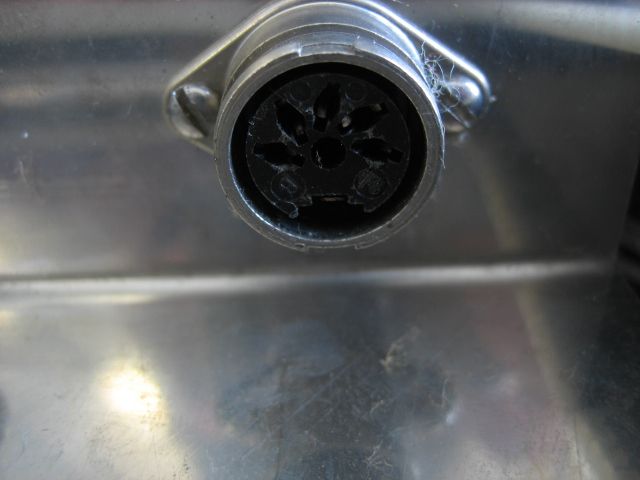If this works like a VT-100, as suggested, then the 5-pin DIN connector will be a serial port to the host. The keyboard seems to have a power or reset button on it, which could use one or two additional lines. So 3 for serial RX, TX and GND and maybe one or two more for RESET, or possibly the other two are serial handshaking lines? I would have got inside it by now to see where the wires lead to. If all five DIN pins lead to a single fairly large IC, they are probably handshaking signals. You can identify them from the pinouts in a datasheet for the relevant UART chip, easily found online.
The RF Video IN/OUT on the CRT mimics the VT-100. Photos haven't shown whether there is another connection between the keyboard and the monitor, but I'm guessing it will be something better than coax RF if this was a serious industrial terminal like the VT100. There'll likely be a 8-16bit CPU, system ROMs and video page RAM in the keyboard unit or in the base of the monitor.
If the thing turns on without any explosions, the next thing I would do (having no documentation) is check that DIN port. A look inside will tell you if any pins are not used. A check with a multimeter will tell whether there is voltage over 5volts on any pin - that will not be a signal pin! Check if any other pin shorts directly to the shield, and identify that as possible ground. Get a male 5-pin DIN plug, plug it in and make the checks on the exposed contacts at the back of the plug with the cover off. Assuming you have a PC with a D9 serial port on it, plug a serial cable into it with exposed wires/contacts at the other end. Open a session in Hyperterminal (or something better) on the PC and make a "connection" at a baud rate something like 9600, opt initially for 8bits,no parity, 1 stop bit and no handshaking. You will be trying to make a "null modem" wiring connection, and you can check which 3 pins on the cable need to be receive, send, and ground (depends whether you have DB9 or DB25 plug).
So long as you don't connect any pin carrying over 5volts, you won't harm the PC by first making a ground connection, and then just connecting the known send and receive lines to different combinations of pins on the DIN connector until you see something appear in the Hyperterminal screen and/or the Thomson screen. If you see garbage on the PC just from making and breaking the connection, test keystrokes on the Thomson. If that doesn't work, exchange the positions of the receive and send wires. If you get something, but not proper response to keystrokes, and your DIN connector has five wires connected rather than just three, then the additional two are probably RTS/CTS handshaking signals and you will need to connect those, most likely in accordance with the RS232 serial connection pinout. It may take some experimenting. You may also need to experiment with any Setup screens available on the Thomson.
There may be people on this forum with Data General experience who might already know more about the serial connection.
Rick

